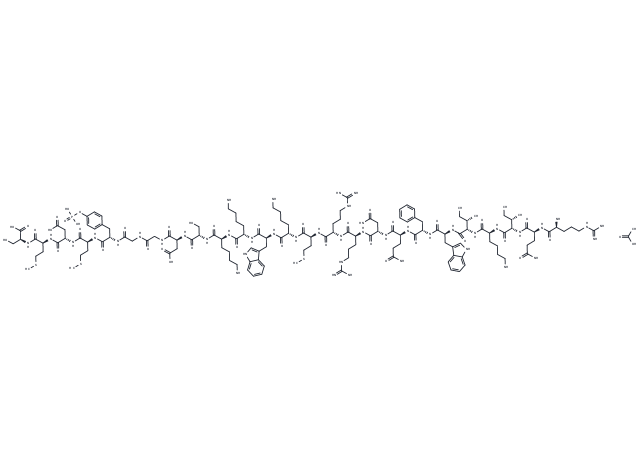Shopping Cart
Remove All Your shopping cart is currently empty
Your shopping cart is currently empty
740 Y-P acetate (740YPDGFR acetate) is a potent and cell-permeable PI3K activator.740 Y-P acetate tends to bind to GST fusion proteins containing the N- and C-terminal SH2 structural domains of p85, but not to GST alone.

| Pack Size | Price | USA Warehouse | Global Warehouse | Quantity |
|---|---|---|---|---|
| 1 mg | $89 | - | In Stock | |
| 2 mg | $139 | - | In Stock | |
| 5 mg | $265 | - | In Stock | |
| 10 mg | $393 | - | In Stock | |
| 25 mg | $658 | - | In Stock | |
| 50 mg | $937 | - | In Stock |
| Description | 740 Y-P acetate (740YPDGFR acetate) is a potent and cell-permeable PI3K activator.740 Y-P acetate tends to bind to GST fusion proteins containing the N- and C-terminal SH2 structural domains of p85, but not to GST alone. |
| Targets&IC50 | PI3K:20 μM |
| In vitro | 740 Y-P TFA (1 μg/mL) stimulates Mitosis at the lowest concentration tested. The peptide stimulates Mitosis in the presence and absence of serum (0.5%). In the former instance, The maximum reaction was observed at 50 μg/mL. 740Y-P stimulation of Mitosis is highly specific, rather than the general characteristics of cell-permeable SH2 domain binding peptides. [1] 740 Y-P TFA (50 μg/ml; 48 h) in the culture medium, the specific stimulation of Mitosis was superior to EGF or FGF in stimulating the entry of S phase, which showed that the percentage of S phase cells in C2 cells was 48.3%. In addition, LY294002 or wortmannin effectively inhibited the Mitosis response stimulated by the 740Y-P TFA peptide. [1] 740 Y-P TFA (30 μM; 24 h) significantly inhibited the levels of LC3-II/LC3-I in GO induced PC12 cells. [2] |
| Synonyms | PDGFR 740Y-P Acetate, 740YPDGFR acetate, 740 Y-P acetate(1236188-16-1 Free base) |
| Molecular Weight | 3330.79 |
| Formula | C143H226N43O41PS3 |
| Smiles | O=P(O)(O)OC(C=C1)=CC=C1C[C@@H](C(N[C@@H](CCSC)C(N[C@@H](CC(O)=O)C(N[C@@H](CCSC)C(N[C@@H](CO)C(O)=O)=O)=O)=O)=O)NC(CNC(CNC([C@H](CC(O)=O)NC([C@H](CO)NC([C@H](CCCCN)NC([C@H](CCCCN)NC([C@H](CC2=CNC3=CC=CC=C23)NC([C@H](CCCCN)NC([C@H](CCSC)NC([C@H](CCCNC(N)=N)NC([C@H](CCCNC(N)=N)NC([C@H](CC(N)=O)NC([C@H](CCC(N)=O)NC([C@H](CC4=CC=CC=C4)NC([C@@H](NC([C@H]([C@@H](C)CC)NC([C@H](CCCCN)NC([C@H]([C@@H](C)CC)NC([C@H](CCC(N)=O)NC([C@@H](N)CCCNC(N)=N)=O)=O)=O)=O)=O)CC5=CNC6=CC=CC=C56)=O)=O)=O)=O)=O)=O)=O)=O)=O)=O)=O)=O)=O)=O)=O.CC(O)=O |
| Relative Density. | no data available |
| Sequence | Arg-Gln-Ile-Lys-Ile-Trp-Phe-Gln-Asn-Arg-Arg-Met-Lys-Trp-Lys-Lys-Ser-Asp-Gly-Gly-{Tyr(PO2)}-Met-Asp-Met-Ser |
| Sequence Short | RQIKIWFQNRRMKWKKSDGG-{Tyr(PO2)}-MDMS |
| Storage | keep away from direct sunlight,keep away from moisture,store at low temperature | Powder: -20°C for 3 years | In solvent: -80°C for 1 year | Shipping with blue ice/Shipping at ambient temperature. | |||||||||||||||||||||||||
| Solubility Information | H2O: 83.3 mg/mL (25.01 mM), Sonication is recommended. DMSO: 83.3 mg/mL (25.01 mM), Sonication is recommended. | |||||||||||||||||||||||||
Solution Preparation Table | ||||||||||||||||||||||||||
H2O/DMSO
| ||||||||||||||||||||||||||
| Size | Quantity | Unit Price | Amount | Operation |
|---|

Copyright © 2015-2026 TargetMol Chemicals Inc. All Rights Reserved.